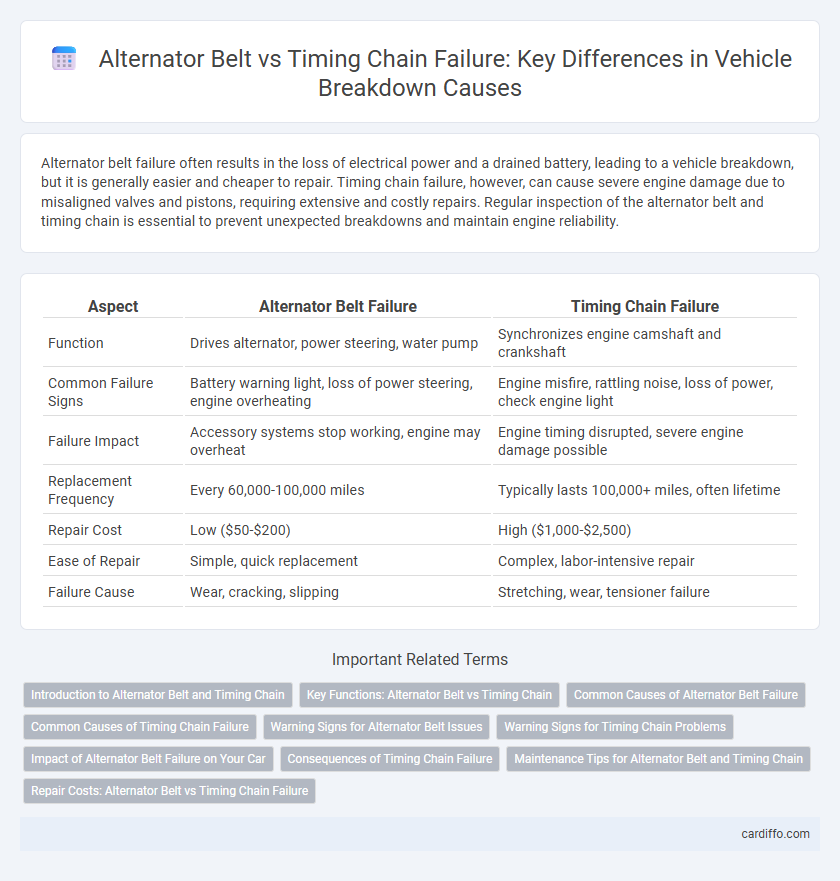Alternator belt failure often results in the loss of electrical power and a drained battery, leading to a vehicle breakdown, but it is generally easier and cheaper to repair. Timing chain failure, however, can cause severe engine damage due to misaligned valves and pistons, requiring extensive and costly repairs. Regular inspection of the alternator belt and timing chain is essential to prevent unexpected breakdowns and maintain engine reliability.
Table of Comparison
| Aspect | Alternator Belt Failure | Timing Chain Failure |
|---|---|---|
| Function | Drives alternator, power steering, water pump | Synchronizes engine camshaft and crankshaft |
| Common Failure Signs | Battery warning light, loss of power steering, engine overheating | Engine misfire, rattling noise, loss of power, check engine light |
| Failure Impact | Accessory systems stop working, engine may overheat | Engine timing disrupted, severe engine damage possible |
| Replacement Frequency | Every 60,000-100,000 miles | Typically lasts 100,000+ miles, often lifetime |
| Repair Cost | Low ($50-$200) | High ($1,000-$2,500) |
| Ease of Repair | Simple, quick replacement | Complex, labor-intensive repair |
| Failure Cause | Wear, cracking, slipping | Stretching, wear, tensioner failure |
Introduction to Alternator Belt and Timing Chain
The alternator belt, also known as the serpentine belt, drives multiple engine components, including the alternator, water pump, and power steering pump, making it essential for vehicle functionality. The timing chain synchronizes the rotation of the crankshaft and camshaft, ensuring precise valve operation and optimal engine performance. Failure of either the alternator belt or timing chain can lead to significant engine breakdowns, requiring prompt diagnosis and repair to prevent costly damage.
Key Functions: Alternator Belt vs Timing Chain
The alternator belt drives the alternator, enabling the vehicle's electrical system to charge the battery and power accessories, while the timing chain synchronizes the rotation of the crankshaft and camshaft to ensure precise engine valve timing. Failure of the alternator belt typically leads to battery discharge and loss of electrical functions, whereas timing chain failure can result in severe engine damage due to valve and piston misalignment. Maintaining both components is critical for reliable engine performance and preventing costly breakdowns.
Common Causes of Alternator Belt Failure
Alternator belt failure commonly results from wear and tear due to continuous friction and heat exposure, leading to cracks, glazing, or fraying. Improper tension, misalignment, or oil contamination further accelerate belt deterioration, causing slipping or snapping. Regular inspection and timely replacement prevent breakdowns linked to alternator belt malfunction.
Common Causes of Timing Chain Failure
Common causes of timing chain failure include inadequate lubrication, worn-out tensioners, and misaligned or stretched chains due to engine overheating or poor maintenance. Frequent oil changes with the correct viscosity and regular inspections of the timing chain system can prevent premature wear and catastrophic engine damage. Ignoring warning signs such as rattling noises or engine misfires often leads to extensive repairs and higher replacement costs.
Warning Signs for Alternator Belt Issues
Warning signs for alternator belt issues include squealing noises during engine start-up and dimming headlights while idling. Visible cracks, fraying, or glazing on the belt surface indicate imminent failure. Reduced battery charge and warning lights on the dashboard often accompany alternator belt problems, signaling the need for immediate inspection.
Warning Signs for Timing Chain Problems
Unusual rattling noise from the engine, especially during startup or acceleration, often signals timing chain wear or damage. Engine misfires, rough idling, and reduced performance may indicate timing chain tension issues or slipping. Warning signs like metal shavings in the oil suggest timing chain failure, requiring immediate inspection to prevent severe engine damage.
Impact of Alternator Belt Failure on Your Car
An alternator belt failure disrupts the charging system, causing the battery to drain rapidly and the vehicle to lose electrical power, leading to engine stalling and potential breakdown. This failure impairs critical components such as headlights, dashboard instruments, and ignition system, compromising safety and drivability. Unlike timing chain failure, alternator belt issues manifest more suddenly but are often easier and less costly to repair or replace.
Consequences of Timing Chain Failure
Timing chain failure can lead to severe engine damage, including bent valves, damaged pistons, and complete engine failure due to the loss of synchronization between the crankshaft and camshaft. This often results in expensive repairs and extended vehicle downtime, significantly impacting reliability and safety. Unlike alternator belt failure, which usually causes electrical issues, timing chain failure directly compromises engine operation and performance.
Maintenance Tips for Alternator Belt and Timing Chain
Regular inspection and timely replacement of the alternator belt prevent slippage and electrical system failures, ensuring consistent engine performance. For the timing chain, maintaining proper lubrication through regular oil changes reduces wear and minimizes the risk of chain stretch or breakage. Monitoring tensioner condition and addressing any unusual noises early can extend the lifespan of both components and avoid costly breakdowns.
Repair Costs: Alternator Belt vs Timing Chain Failure
Repair costs for an alternator belt replacement typically range from $100 to $350, depending on the vehicle model and labor rates, since the belt is relatively accessible and easier to replace. Timing chain failure repair is substantially more expensive, often costing between $1,000 and $3,000 or more due to the complexity of disassembling engine components and potential engine damage. The higher cost for timing chain repair reflects the precise mechanical work and time-intensive process required compared to the simpler alternator belt replacement.
Alternator belt vs timing chain failure Infographic

 cardiffo.com
cardiffo.com